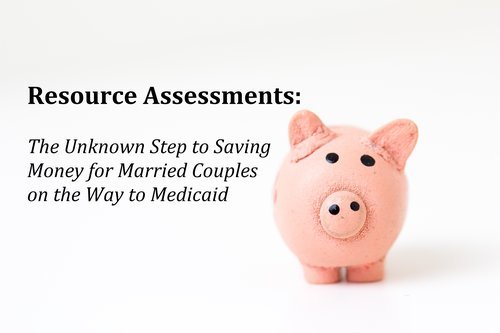Resource Assessments: The Unknown Step to Saving Money for Married Couples on the Way to Medicaid
Many married couples are unaware of an important element of asset preservation when faced with long term care expenses -- the Medicaid Resource Assessment. A portion of the Medicaid rules is designed to protect the community spouse (spouse at home) from impoverishment and unnecessary dissipation of family assets. Only the institutionalized spouse (spouse in a facility) is required to have assets of $2,000 or less and a pre-paid funeral.
The inspiration for this article came from a very recent trip to the Medicaid office by one of our staff members. She was waiting to speak to a caseworker and began to chat with a parents had spent down all of their assets, more than $100,000, in order to reach a balance of $2,000 so his father could be Medicaid eligible. She came to my office afterwards, heartbroken for the man and his family. They never knew about or obtained a Resource Assessment from the Medicaid office.
The failure to have a proper Resource Assessment in a timely manner can cost couples thousands and even hundreds of thousands of dollars. The community spouse is entitled to keep a portion of the family assets and the Medicaid office establishes that amount at the time of the Resource Assessment. During the Resource Assessment, the caseworker will look at the countable assets belonging to the couple and allocate them between them. Depending on the amount of the countable resources, the community spouse can keep half the amount (or a minimum of $23,844 up to $119,220). At that time the caseworker will determine the amount of the spenddown (if one is necessary) in order to qualify for Medicaid.
The Resource Assessment operates as a snapshot of the assets owned by a married couple. A delay in obtaining the assessment will reduce the amount of assets available to be set aside to the community spouse. It is better to obtain the Resource Assessment sooner rather than later (within the first couple of months of institutional placement) when assets are higher rather than lower – yes, you want to walk into the Medicaid office for your Resource Assessment owning more assets than less! The patient usually is not eligible for Medicaid at the time of the assessment which makes the assessment even more important. It may not make sense until you see how it works.
EXAMPLE:
Judy and John, a long-time married couple, were devastated when Judy had to be placed in the nearby skilled nursing facility. Judy and John were both well-educated individuals and knew that for Judy to be eligible for Medicaid, they would have to spend down their resources. John read articles in magazines and the internet about Medicaid. He knew Judy could only have $2,000 in assets. Both of them have retirement accounts, they own their home and one car, and John has $80,000 in a non-retirement investment account.
The Wrong Way for Judy to qualify is to spend down all their assets until they have only $2,000 in family assets. While she will certainly qualify when the application is made, John will be without assets that he could have retained.
The Right Way for Judy to qualify is to get a Resource Assessment as soon as Judy goes to the nursing home. The Medicaid caseworker will tally up the countable assets, which, in this case, is only the $80,000 account (because, in the state of Kentucky, the retirement accounts are exempt assets) and then divide the assets in half. Judy gets $40,000 in her “bucket.” John gets $40,000 in his “bucket.” The home and the car are exempt for the community spouse. John and Judy’s spend-down amount is $38,000; they will need to spend the funds in Judy’s “bucket” until her assets are only $2,000. These monies can be spent on either of them. John could buy a new car, pay down the mortgage, remodel the home, buy special things for his wife like a new TV or clothing. After Judy’s bucket is at $2,000 or less, she can apply for Medicaid and will be eligible.
TIPS FOR YOUR RESOURCE ASSESSMENT:
1. Clean up extraneous bank accounts. Think about closing or consolidating accounts you no longer use.
2. After a nursing home placement, the community spouse’s income should be deposited into a separate checking accounts in his or her name alone. The institutionalized spouse’s income should continue to be deposited into a checking account owned jointly with the community spouse. The joint account should be used for the institutionalized spouse alone. Any allocation of income from the institutionalized spouse to the community spouse should be transferred to the community spouse’s account before being spent for the community spouse.
3. After the Resource Assessment, think about moving the spend-down funds to a separate account and spending from that account. When the account has been depleted, it is time to make the Medicaid application if the patient is in a Medicaid designated bed.
4. Keep all your bank records and purchase receipts and be prepared to trace all your fund transfers.
5. The Medicaid worker should give you or your representative the Resource Assessment with the spend-down amount. (This form is PA-22.) Do not leave the office without it because the Medicaid office will not retain a copy for you.
Interactions with the Medicaid Office can be overwhelming. If you want to know more or need help, contact a qualified elder law attorney.
By Mary Ellis Patton, Bluegrass Elderlaw, PLLC, 120 N Mill Street, Ste 201, Lexington, KY 40507, www.bgelderlaw.com


